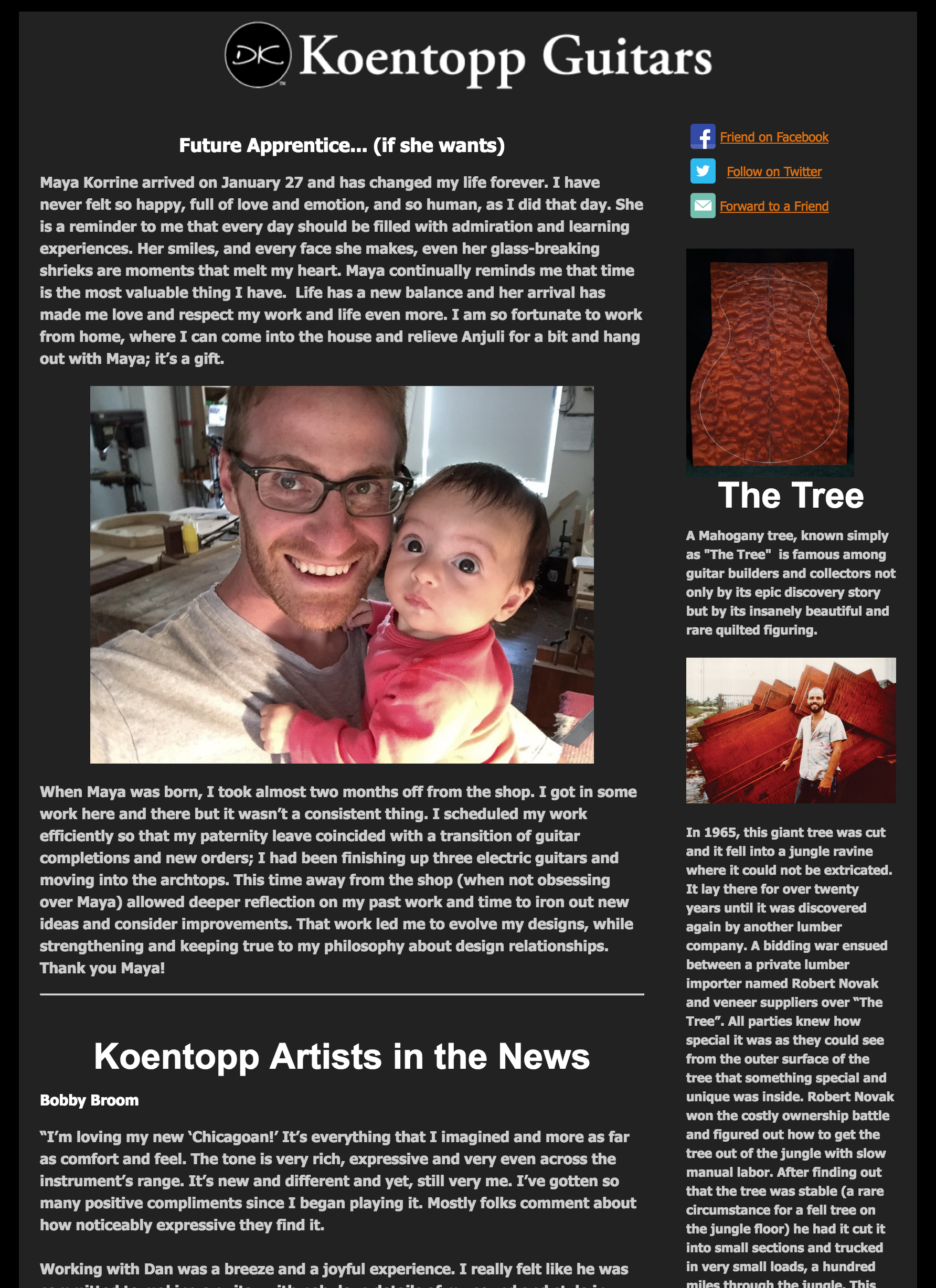Mahogany Archtops, Electrics and a Baby!
Click the image below to read the full newsletter.
The latest update from Koentopp Guitars, please subscribe to receive updates via email.
Tags: acoustic guitar, Andy Brown, archtop, archtop guitar, Archtop Guitar making, Bobby Broom, chicagoan, custom archtop, custom guitar, Don Stiernberg, Guitar, guitar builder, handmade

Is the mahogany Amati to the point that you can hear the difference from the maple body relatives? If so, how does it differ?
Hi Alan, thanks for the question! I’m still in the process of french polishing but from carving and graduating the Mahogany, it’s voice and fundamental frequency is much lower than traditionally with maple. Once I string it up I’ll have a conclusive answer but it’s pretty clear evidence that the Mahogany back and sides will support the lower end of the frequency spectrum. It should help bring out the mids, which is a common Mahogany trait. –Danny
Hello Dan, I love your work. I’ve had a career in woodworking of a different specialty–restoration of high quality 18th century furniture, especially carving. I don’t understand from your photos, blogs, and interviews exactly how the top and back plates join the sides on your cutaway guitars. As you explain, the arch of your tops and bottoms do not follow the outer shape of the cutaway in the theory that that would make them more rigid and limit vibration. Most other archtops have tops and bottoms with arching following the cutout shape so the top and bottom plates are entirely flat as they join the sides. Details of your cutaways (and Collins, Grimes, and Parker guitars) show tops and bottoms with your theory. Your binding becomes higher in the cutout to meet the top and bottom plates. But what is glued to the uniform width sides in this area? Do the tops and bottoms have extra thickness left to reach the sides? This would seem to cause a worse rigidity problem. Does the binding bridge the gap and form the effective joint with the sides? There would be a gap between the top and bottom in the cutout area until the binding is applied if this is the case. The only maker I know of who increases the height of the sides in the cutaway to meet the top and bottom is Parker. I’d love to understand this. Thanks, Alan
Thank you so much Alan! Your work looks incredible! Thanks for sharing the images with me.
When I do a cutaway I leave the edge at the highest point of the cutaway, on both plates, a little thicker in order to meet the sides. I used to do it all uniform with an interior lining but I didn’t see any difference besides the extra work involved. You are right that the extra thickness adds more rigidity and a tiny bit of extra mass. However, I’ve done guitars with no extra thickness, no arch drop, and I can not tell or hear a notable difference. The cutaway shape, the sharp curves, add so much stiffness to that area regardless of the plate design. I feel that by the time the top/back becomes flexible, they are already at their appropriate thickness’. Parkers method is a very cool and smart approach and you can see how it’s done from the outside. In a way, I like the other method better because it plays a trick on the eye, makes someone say “how is that done?”. Its look is more dynamic with the rims staying the same height. It also keeps the aesthetic balance of the arching, which is one of the most beautiful shapes! The way to do a plate at uniform thickness, without tapering the height of the sides is to add a taller lining (or kerfing) on the inside of the side and conform it to the plates. This is exactly what Parker is doing but he is changing the height of the sides as well (Parker increases the sides not only because he has a thinner top at that area but because he doesn’t bind his edges). There are a number of old violins and cellos with a thicker area around the neck blocks and the tailblocks; the thickness travels from the depth of the blocks in a straight line and across till it meets the bouts. The beauty of all this is the only thing that is right is what works best for you! 😉 Thanks again for the comment and great question Alan! I hope you get the archtop itch scratched! –Danny